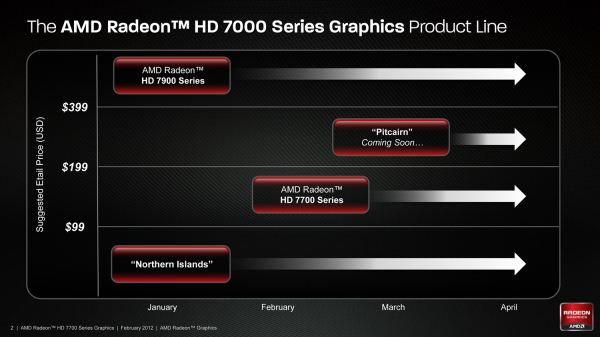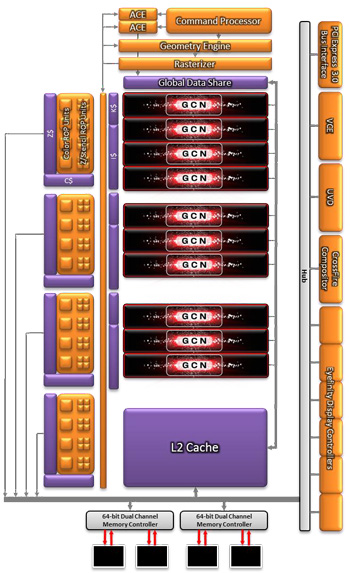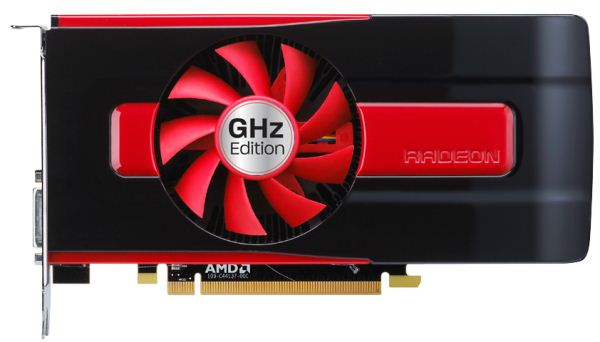AMD Radeon HD 7750 & Radeon HD 7770 GHz Edition Review: Evading The Price/Performance Curve
by Ryan Smith & Ganesh T S on February 15, 2012 12:01 AM EST- Posted in
- GPUs
- AMD
- HTPC
- GCN
- Radeon HD 7000
With the launch of Tahiti behind them, AMD is now firing on all cylinders to get the rest of their Southern Islands lineup out the door. Typically we’d see AMD launch their GPUs in descending order of performance, but this time AMD is taking a slight detour. Rather than following up the Tahiti based 7900 series with the Pitcairn based 7800 series, AMD is instead going straight to the bottom and launching the Cape Verde based 7700 series first.
Today AMD will be launching two cards based on the Cape Verde GPU: the Radeon HD 7750, and the Radeon HD 7770 GHz Edition. As the Juniper based 5700 series never got a proper Northern Islands successor, this is the first real update for the x700 series since the launch of the 5700 series in October of 2009. Given the success of the 5700 expectations are going to be high, and to fulfill those expectations AMD will be bringing to bear their new GCN architecture along with a full node jump with TSMC’s 28nm process. But will this be enough to enable the 7700 series to replicate the success of the 5700 series? Let’s find out.
| AMD GPU Specification Comparison | |||||||
| AMD Radeon HD 7770 GHz Edition | AMD Radeon HD 7750 | AMD Radeon HD 6850 | AMD Radeon HD 5770 | AMD Radeon HD 5750 | |||
| Stream Processors | 640 | 512 | 960 | 800 | 720 | ||
| Texture Units | 40 | 32 | 48 | 40 | 36 | ||
| ROPs | 16 | 16 | 32 | 16 | 16 | ||
| Core Clock | 1000MHz | 800MHz | 850MHz | 850MHz | 700MHz | ||
| Memory Clock | 4.5GHz GDDR5 | 4.5GHz GDDR5 | 4.8GHz GDDR5 | 4.8GHz GDDR5 | 4.6GHz GDDR5 | ||
| Memory Bus Width | 128-bit | 128-bit | 256-bit | 128-bit | 128-bit | ||
| Frame Buffer | 1GB | 1GB | 1GB | 1GB | 2GB | ||
| FP64 | 1/16 | 1/16 | N/A | N/A | N/A | ||
| Transistor Count | 1.5B | 1.5B | 1.7B | 1.04B | 1.04B | ||
| PowerTune Limit | 100W | 75W | N/A | N/A | N/A | ||
| Manufacturing Process | TSMC 28nm | TSMC 28nm | TSMC 40nm | TSMC 40nm | TSMC 40nm | ||
| Architecture | GCN | GCN | VLIW5 | VLIW5 | VLIW5 | ||
| Price Point | $159 | $109 | ~$149 | ~$99 | ~$89 | ||
With the 6000 series AMD effectively had a 5 chip stack: Caicos (6400), Turks (6600), the rebadged Juniper (6700), Barts (6800), and Cayman (6900). Since then integrated GPUs have effectively wiped out the low end of the market, and by the time Trinity launches later this year any product short of 6600 performance should be made redundant. As a result AMD has reigned in on their spread out stacks, leading to their 28nm Southern Islands product stack being just 3 products: Cape Verde (7700), Pitcairn (7800), and Tahiti (7900). Anything below the 7700 series will be rebadged Northern Islands parts, primarily Turks and Caicos.
But AMD’s product stack doesn’t tell the whole story. AMD will need to cover a wide range of products and price levels with only 3 GPUs, ranging from $109 to $550. As a result the performance levels of AMD’s various product series are being redefined somewhat, and nowhere is this more apparent right now than with the 7700 series. Why do we say that? Well let’s take a look at the specs and pricing.
Cape Verde, the GPU at the heart of the 7700 series, is AMD’s smallest 28nm GPU. With a die size of 123mm2 it’s only a hair bigger than the 118mm2 Turks GPU that powers the 6600 series. In terms of functional units we’re looking at 10 Compute Units, giving Cape Verde 640 SPs and 40 texture units. Elsewhere Cape Verde packs 16 ROPs, 1 geometry engine/rasterizer pair, and 512KB of L2 cache, with the chip coupled to a 128bit GDDR5 memory bus. Altogether compared to Tahiti this is around 31% of the CUs, 33% of the memory bus width, and half as many ROPs.
Interestingly, unlike Tahiti, Cape Verde’s CUs are organized slightly differently. GCN is designed around 4 CUs in each CU Array, with the 4 CUs sharing a read-only L1 instruction cache and a read-only L1 data cache. This is how both the 7970 and 7950 are organized, with the 7950 simply lopping off a whole CU array. However with Cape Verde 10 CUs doesn’t cleanly divide into groups of 4, so for the first time AMD has built something a bit different. In Cape Verde there are 3 CU arrays, populated in a 4/3/3 manner. With regards to performance there shouldn’t be a huge difference, but this does mean that there’s a bit less cache pressure on the CUs occupying the smaller CU arrays.
On the functionality side of things, backing up Cape Verde will be the rest of the Southern Islands family features we’ve already seen on Tahiti, such as DX10+ SSAA, PowerTune, Fast HDMI support, partially resident textures, D3D 11.1 support, and the still-AWOL Video Codec Engine (VCE). Even FP64 support is accounted for, however similar to how NVIDIA handles it on lower-end parts it’s a performance-limited implementation for compatibility and software development purposes, with FP64 performance limited to 1/16th FP32 performance.
As for the cards themselves, AMD will be releasing two Cape Verde cards: the Radeon HD 7750, and the Radeon HD 7770 GHz Edition. The 7770 will be a fully enabled Cape Verde with all 10 CUs (640 SPs) enabled, running at 1GHz for the core clock and 4.5GHz for the memory clock, with a PowerTune limit of 100W and an AMD defined typical board power of 80W. The 7750 meanwhile has 2 disabled CUs, giving it 512 SPs and 32 texture units, while the ROP count is unchanged at 16. The core clock will be 800MHz while the memory clock is the same as the 7770 at 4.5GHz, with a PowerTune limit of 75W and a typical board power of 55W. Both cards have a sub-10W idle TDP, while long-idle is sub-3W.
With those specs in mind, it’s interesting to note that the difference between the 7750 and 7770 is much wider than we’ve seen in past products. Compared to the 7750, the 7770 has 25% more CUs and a 25% core clock advantage, giving it a massive 56% shader and texture performance advantage over the 7750. With the 5700 series this gap was only 35%, and most of that was a result of core clock differences. The fact that the memory bandwidth is the same between the 7770 and 7750 equalizes things somewhat, but it’s still a huge difference for two cards that are in the same family.
This brings us back to where we started: how AMD is covering the entire $109+ market with only 3 GPUs. Between the massive performance gap between the 7700 series cards and the fact that the 7750 is a sub-75W part, it becomes increasingly obvious that the 7700 series is the de-facto replacement for both the 6600 series and the 5700 series. The 7750 will fill the 6670’s old role as AMD’s top sub-75W card, but as we’ll see its performance means it won’t be a complete replacement for the 5700 series. Instead the role of replacing the 5700 series falls to the much more powerful 7770.
As for today’s launch, AMD will be launching the 7750 at $109 and the 7770 at $159, which happens to be the same prices the 5770 and 5750 512MB launched at respectively. With midrange cards there usually aren’t any supply issues and we aren’t expecting the 7700 series launch to be any different, however as is customary AMD’s partners will be launching semi-custom cards from day one, so pricing will probably be inconsistent.
At these prices the 7700 series will be competing with a number of last-generation cards. The 7750 will be up against AMD’s 5770/6770 and the absolute cheapest of NVIDIA’s GTX 550 Ti cards. Meanwhile the 7770 will be competing with AMD’s 6850 and 6870, along with NVIDIA’s GTX 460 and their cheapest GTX 560s. And as we’ll see in our benchmarks, this is ultimately going to be more than the 7700 series can handle.
| Winter 2011/2012 GPU Pricing Comparison | |||||
| AMD | Price | NVIDIA | |||
| $209 | GeForce GTX 560 Ti | ||||
| $179 | GeForce GTX 560 | ||||
| Radeon HD 6870 | $169 | ||||
| Radeon HD 7770 | $159 | ||||
| Radeon HD 6850 | $139 | ||||
| $119 | GeForce GTX 550 Ti | ||||
| Radeon HD 7750 | $109 | ||||
| Radeon HD 6770 | $99 | ||||













155 Comments
View All Comments
Dug - Wednesday, February 15, 2012 - link
For the cost of one game you could just get the nvidia 560. In fact you could of gotten it a long time ago and still be way ahead.beginner99 - Wednesday, February 15, 2012 - link
Well seeing this makes me feel a little less bad on how much a paid for my 5850 1.75 years ago. Absolutely 0 reason to upgrade...However now it seems AMD GPU division is starting to blunder too...
solarTermination - Wednesday, February 15, 2012 - link
I really don't understand what AMD is thinking here. The 7770 is preposterous at this performance/price level, and it boggles the mind that they designed it this way. I'm really stumped here, it's like they're spitting in all of our faces to release a card that has less performance and costs more than a widely available 2 year old part.They must take us for fools. Nothing else could explain this. Technology is supposed to improve as the years go by, not tread water, and certainly not get worse. You see this kind of bs and the revolving door of talent at AMD starts to make more sense. There must be some real pieces of work running that place.
I think it's finally time to join them. Nvidia, here i come.
CeriseCogburn - Saturday, March 10, 2012 - link
It's obvious isn't it ? They are a collapsing wreck that have culled with the ax their dwindling workforce as they've sold off assets to leave them with nothing but ip.Now after striking away Bain Capital style at the failing red bottom line - in the deep debt for endless years under the tightwad whining fan base and OCD focused complaint review sites meshing pennies and fps to an insane nuovo art form that should embarrass it's fans rather than fill them with false self esteem and self congratulating "I'm brilliant" mirror apprasials, they must further the save their life goal and actually ask their tenderly coddled and deceived rabid fan base to cough up some survival dollars...
Unfortunately, the years of low price bragging filled with lies albeit effectiveness as an ignorant fool lives in bliss, has come to backfire on them at the worst time possible, the end of the line.
As Mr. Smith said, it was inevitable.
Now amd needs a hero to save it's collapse and absorption into the wider market matrix.
shin0bi272 - Wednesday, February 15, 2012 - link
I have a gts250 and I get about the same fps as the 7750. I paid just over 100 bucks (109 IIRC) for it and its almost 3 years old and keeps up with these brand new cards. I cant decide if that's funny or sad.Menoetios - Wednesday, February 15, 2012 - link
While these cards definitely deserve flak for their starting prices, I'm not nearly as disappointed overall as many here seem to be. I have no doubt that their prices will come down in time. Consider that the 7750 is the absolute slowest GCN card. I fully expect to see a tastey sub-$90 price for the 7750s by the time Nvidia gets their 28nm line out. The 28nm process is still extremely supply constrained; it wouldn't make sense to price the cards out any lower to increase sales when there simply aren't any to sell. Whether Kepler trounces GCN or equals it, its introduction will be when the real shift in the price/performance shift occurs, both from competitive pricing as well as the 28nm ramp up.kmmatney - Wednesday, February 15, 2012 - link
Well, I'm glad I was able to pickup an HD6850 for $139 shipped (no rebates). I can see why the 7750 would be great for notebooks, but I don't see much point in this card for the desktop.CknSalad - Wednesday, February 15, 2012 - link
I think it's safe to say that ever since the release of bulldozer, AMD has been hit hard financially. They spent a lot of R&D and probably put all their eggs in one basket in that project. As much as their efforts can be admired, it seems that this has taken so much of AMD R&D money that now they don't have much to offer for even their gpu lineup.I understand that there is little competition and that this is the 'first gen' of 28nm cards, but there should seriously be at least 10-15% performance boost for the whole lineup. Going from 40nm to a 28nm process is a big jump. The 'there is little competition' so these cards are priced this way is still unacceptable. I'm starting to be wary of the 7800 series cards as I'm looking forward to buying a card no more than the low $300 range.
Hopefully Nvidia has something up their sleeves and can give us true 28nm performance we should be seeing. I am in no way an nvidia fanboy as I have had both ati and nvidia cards. The only thing i worry for nvidia's kepler cards is the power consumption. However, if the performance gain more than makes up for the minor increases in power consumption, then it will be more than worth it.
Sttm - Wednesday, February 15, 2012 - link
Yes they are price gouging for the next 3 months because they can. Also the 7700 series is complete shit performance wise and will only find its home in the hands of the uninformed and the low power systems built by Dell and HP.Nvidia is the only hope of seeing a good price/performance boost now.
Sttm - Wednesday, February 15, 2012 - link
"and at that point, this card at 159$ would make sense."No it wouldn't actually, since with the move to 28nm you should be seeing a performance increase per dollar not the same. The performance of a 6850 should be around $79 this generation, with the $160 cards offering almost 6950/560ti level of performance.
This is what Nvidia will most probably be offering with their next gen parts, and what AMD will have to lower their costs to if they expect anyone outside of the fanboys to but them.